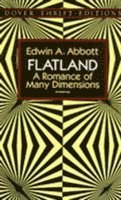
At some point during my first year at university I heard of a book that outlined the life in a world containing only two dimensions in a rather mathematical fashion. When I asked people I thought were well versed in that type of literature, I was directed to the series of books about Discworld by Terry Pratchett. That was a bit disappointing for me, because I was hoping for something dry and clean to read and instead I was served an already then lengthy series filled with life and parodies of fantasy clichés. When I 29 years later received a book as a gift from my sister, I realised that it was the actual book I had been interested in such a long time ago. The book is Flatland: A Romance of Many Dimensions. It was written by Edwin A. Abbott and was first published in 1884.
In Flatland: A Romance of Many Dimensions, the narrator, A Square, explains how life works in his two-dimensional world (Flatland) to a three-dimensional reader (living in Spaceland). For instance, the social status of the male inhabitants (polygons) is determined by their regularity and their number of sides where more sides equals higher status. The women are simple line segments. In a two-dimensional world, what people see is the one-dimensional projections of the two-dimensional structures in the world (compared to us seeing in two dimensions). This can make it difficult to actually see women from certain directions, hence they are required by law to make a certain sound (a peace-cry) whenever they are moving. It is clear that the narrator knows more about higher dimensions than would be expected, but this is explained in the second half of the book where he gets a chance to visit Spaceland and to see his own world from a new direction he did not know could exist.
The book is a dry as I had expected, but it also goes into unexpected directions. The story is very short, but it is still filled with details making the reading condensed. It was difficult for me to read more than a couple of pages of Flatland: A Romance of Many Dimensions at a time because of this. There was simply too much to take in. I think that the book is very good, and I have also understood that is a pioneering work in science fiction by introducing dimensionality into literature and hence opened up mindsd for ideas lying at the centre of moder physics. The book is also a satire about life, society and culture in the Victorian era, so it has a multitude of dimensions in itself. It is a short but entertaining read.
(Flatland is also the name of the company through which I found the studio flat in Pimlico where I lived from 2006 to 2009, but that is completely irrelevant here.)